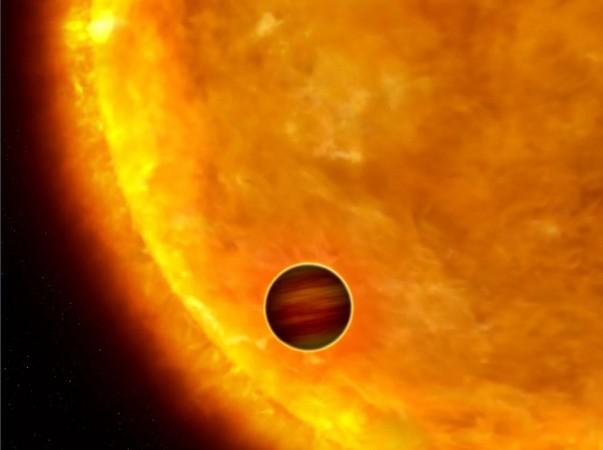
A study found that an enormous planet, which is extremely close to its star, will eventually burn up in about 550,000 years.
Also Read: NASA astronaut claimed he saw dead aliens after infamous Rosewell UFO crash! [VIDEOS]
The planet began its death spiral into its parent star more than two billion years ago.
Researchers believe that the extreme atmospheric temperatures could give them an insight into atmospheres on other alien planets orbiting close to their stars. This study might even help researchers in the search for alien in far-off galaxies.
More than 3,450 planets have been discovered outside our solar system over the last 25 years. The new planets comprise various exoplanets.
"Hot Jupiters" are another kind of gas giants that orbit their stars at a closer proximity than Mercury orbits the Sun.
In order to understand the composition and weather of an exoplanet, researchers need to examine its atmosphere.
"The ultimate goal of such exoatmospheric studies would be to measure the presence of a biomarker molecule," said Thomas Oberst, the lead author of the study and an astrophysicist at Westminster College in New Wilmington, Pennsylvania.
"Biomarkers can serve as evidence of biological activity such as photosynthesis," he elucidated.
Oberst revealed that the technology required to identify biomarkers will only be available after several decades. But we can observe and study the atmospheres of hot Jupiters using telescopes and technology we possess right now.
"As such, hot Jupiters are currently the most valuable 'laboratories' for building and refining our understanding of and techniques for observing exoplanetary atmospheres," he stated.
The researchers analysed a hot Jupiter — KELT-16b — with the help of Kilodegree Extremely Little Telescope (KELT), which is an astronomical observation system created using two telescopes.
The astronomers found the hot gas giant planet was 1.4 times wider than Jupiter and weighed 2.75 times more. Situated around 1,300 light-years from Earth, KELT-16b orbits a star — KELT-16 — which is around 1.2 times more massive than the Sun.
The distance at which KELT-16b orbits its star is around 0.02 AU, approximately 1/20 the distance between the Sun and Mercury. The planet is likely to grow as hot as 4,000 degrees Fahrenheit (2,200 degrees Celsius).
The KELT-16 star has another red dwarf star as companion, along with the gas giant. The red dwarf star orbits around 286 astronomical units (AU) from the star. The average distance between the Sun and Earth is equal to 1AU, which is 93 million miles (150 million kilometers).
On the basis of current models, researchers guesstimate that the planet might have originally orbited the star at a distance of around 5 AU. The companion red dwarf star's gravitational force might have disturbed its orbit and reduced the proximity between the planet and it star.
"Most, if not all, hot Jupiters are likely to end up being tidally disrupted," said Keivan Stassun, study co-author and a researcher at Vanderbilt University in Nashville, Tennessee, as reported by Space.com.
"For KELT-16b in particular, the researchers have precise details on the age of the system and the way in which it evolved, so they can pinpoint the likely timing of the planet's death — and it is imminent," Stassun said further.
So far only six planets have been discovered that orbit their stars in less than 24 hours and KELT-16b is one of them, Oberst revealed.
The planet orbits its star with enough regularity to help researchers analyse the starlight passing through the atmosphere of the planet and study its composition.
"The planet's large size and the amount of light it gets from its star will also make gleaning atmospheric details about KELT-16b easier than [with] most other hot Jupiters," Oberst said.
"The researchers said they hope this giant planet will help answer questions such as what happens at the boundary line between night and daylight, called the terminator, on such a highly irradiated world. If its temperature cools enough in going from the dayside to the nightside, KELT-16b may have rain showers of titanium oxide and vanadium oxide at sunset," Oberst said, as quoted by Space.com.
This will also help the researchers in finding out how exoplanets evolve with time.

















